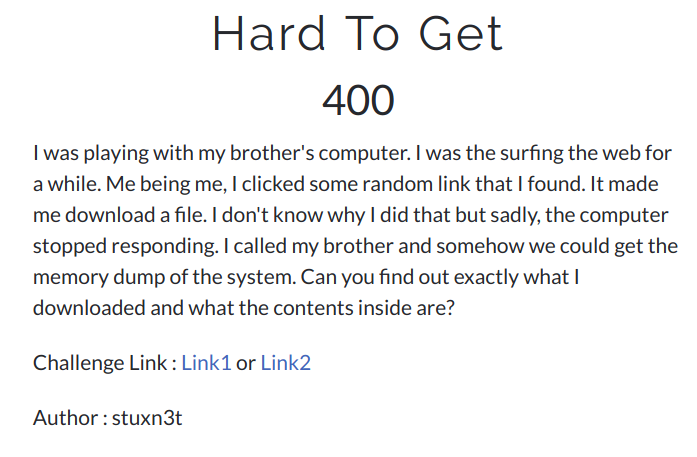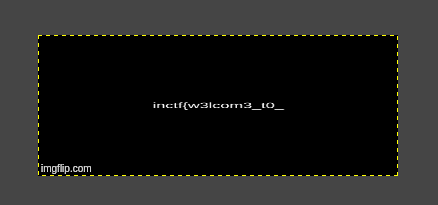InCTF and VMware CTF Forensics
21-01-2019
I will share writeups for two forensics challenges, which I solved during InCTF quals (only 4 teams were able to solve it) and onsite VMware CTF (around 3 individuals solved it).
InCTF challenge

Read the problem statement carefully, the victim downloaded malware. So my initial steps were :
- Check Downloads directory
- Find the browser present on system
So we were provided with memory dump of a computer system, and we can use volatility tool to analyze this memory dump.
C:\Users\r0hanSH\Downloads\Challenge>volatility.exe -f Challenge.raw imageinfo
Volatility Foundation Volatility Framework 2.6
INFO : volatility.debug : Determining profile based on KDBG search...
Suggested Profile(s) : Win7SP1x86_23418, Win7SP0x86, Win7SP1x86
...
Then check processes
C:\Users\r0hanSH\Downloads\Challenge>volatility.exe -f Challenge.raw --profile=Win7SP1x86_23418 pslist
Volatility Foundation Volatility Framework 2.6
Offset(V) Name PID PPID Thds Hnds Sess Wow64 Start Exit
---------- -------------------- ------ ------ ------ -------- ------ ------ ------------------------------ ------------------------------
0x83d09c58 System 4 0 84 496 ------ 0 2018-12-02 14:26:26 UTC+0000
0x84430020 smss.exe 260 4 2 29 ------ 0 2018-12-02 14:26:26 UTC+0000
0x84c3e7f8 csrss.exe 340 332 9 368 0 0 2018-12-02 14:26:31 UTC+0000
...
...
0x84ff1d20 chrome.exe 2300 1004 39 887 1 0 2018-12-02 14:32:44 UTC+0000
...
So we can see a lot of processes are there, but interesting one is chrome.exe . So we can assume the victim was using Chrome browser to download the malware. So what can we do ? During CTF, I dumped chrome’s history files. But later I came to know volatility has chromehistory plugin available.
With filescan plugin I searched for history files of chrome and dumped onto my local machine. After checking the content of dumped files, I come across this link which contains a file called Image.png
So now comes steganography part, I opened Image.png but it was not a picture at all, it was plain ASCII text. After analysing the content, I came to know it’s in hex. Starting content was
504B0304
It’s the file signature of a zip file.
localhost@r0hanSH:~$ xxd -r -p Image.png > file.zip
The file.zip was protected with password. So I tried fcrackzip to crack the password using different wordlists but nothing worked. So again, I started anaylising the memory dump. Next thought was what could be the password? Could it be the password of local user?
C:\Users\r0hanSH\Downloads\Challenge>volatility.exe -f Challenge.raw --profile=Win7SP1x86_23418 hashdump
Volatility Foundation Volatility Framework 2.6
Administrator:500:aad3b435b51404eeaad3b435b51404ee:31d6cfe0d16ae931b73c59d7e0c089c0:::
Guest:501:aad3b435b51404eeaad3b435b51404ee:31d6cfe0d16ae931b73c59d7e0c089c0:::
hello:1000:aad3b435b51404eeaad3b435b51404ee:a0ce834dafdfabf08cc996ba5a6bba31:::
Decrypting the NTLM hash of user “hello” gives zip password “inctfiseasy”. After unzipping the file.zip, we got another file named “hex” which also contains plain ASCII text with starting content “474946383961” and that’s the file signature of a GIF file.
localhost@r0hanSH:~$ xxd -r -p hex > flag.gif
The speed of gif was very high, so I opened it in GIMP and see individual layers and came across this.

So now we got first part of the flag. Let’s hunt for second part. After a lot effort, I found this in environmental variables.
C:\Users\r0hanSH\Downloads\Challenge>volatility.exe -f Challenge.raw --profile=Win7SP1x86_23418 envars
Volatility Foundation Volatility Framework 2.6
Pid Process Block Variable Value
-------- -------------------- ---------- ------------------------------ -----
260 smss.exe 0x001907f0 Path C:\Windows\System32
260 smss.exe 0x001907f0 SystemDrive C:
...
...
340 csrss.exe 0x002c07f0 The Final Part 6D795F7730726C645F30665F6D336D3072597D
340 csrss.exe 0x002c07f0 The Hacker My NTLM can crack anything
340 csrss.exe 0x002c07f0 TMP C:\Windows\TEMP
340 csrss.exe 0x002c07f0 USERNAME STARK
...
localhost@r0hanSH:~$ echo 6D795F7730726C645F30665F6D336D3072597D | xxd -r -p
my_w0rld_0f_m3m0rY}
Finally, we got the flag inctf{w3lcom3_t0_my_w0rld_0f_m3m0rY}
VMware CTF
It may seems easy but it wasn’t. I don’t have files available right now. So I will be explaining the methodology I followed but important thing is to learn this technique.
We were provided with a zip file say flag.zip But it was password protected, so I cracked it using fcrackzip along with rockyou.txt . I don’t remember the password right now but it was having word “rain” in it. It will help later on.
So now I got a PDF file, real hunt begins now. I tried everything I know. But outcome was 0. I noticed that word “rain” in zip file password. Why would one make a zip file password protected, when there are good hackers and everyone of them knows how to crack zip password ? So I used google to know what technique it could. After a lot of effort, I got to know about SNOW tool. So this was a Whitespace steganography challenge and used SNOW to get the flag.
./snow -C flag.pdf